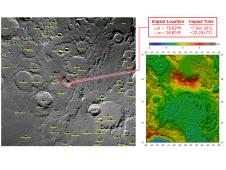A pair of twin spacecraft that orbit the moon and allow scientists to study the structure and internal composition of the moon, are about to crash in a controlled crash on Monday 17/12/2012 night (17:28 EST, 00:28 Tuesday Israel time).

A pair of twin spacecraft that orbit the moon and allow scientists to study the structure and internal composition of the moon, are about to crash in a controlled crash on Monday 17/12/2012 night (17:28 EST, 00:28 Tuesday Israel time).
Ebb and Flow, or in Hebrew Tides, two spacecraft that make up the GRAIL mission - the laboratory for reconstructing the gravity and internal composition of the moon, will be launched deliberately to crash towards the surface of the moon because their low orbit and small fuel reserves will prevent further scientific activity. The main missions as well as the extension made it possible to prepare the highest resolution map of the gravity field of any celestial body. The map will provide a good understanding of how Earth and other rocky planets in the solar system formed and evolved.
"It's going to be hard to say goodbye," said GRAUK project principal investigator Maria Zuber of the Massachusetts Institute of Technology in Cambridge. "Our little robotic twins in the GRAIL mission have already become family members and planetary science has advanced significantly thanks to their contribution."
The mountain into which the two spacecraft crashed is located near a crater called Goldschmidt. The two spacecraft have been floating in formation around the moon since January 1, 2012. They were named by elementary school students in Montana who won the competition. The first spacecraft to reach the moon, the Ebb, would also be the first to crash. Flow will join her 20 seconds later. Both spacecraft will hit the moon at a speed of 1.7 kilometers per second, but the impact will not be visible to the eye because the area is expected to be in shadow at the time.
"Gaot" and "Shefel" will conduct a final experiment before completing their mission. ends They will drain the fuel from the engines so that the amount of fuel left in their tank can be measured exactly. This will help NASA engineers validate fuel consumption computer models in order to improve fuel consumption predictions on future missions.
"Our lunar twins may be in the twilight of their operational lives, but one thing's for sure, they're going down swinging," said GRAIL Project Manager David Lehmann of NASA's Jet Propulsion Laboratory in Pasadena, Calif. "Even in the last half of their final orbit, we're going to do an engineering experiment which can help future missions operate more efficiently."
Since the exact amount of fuel left on board each spacecraft is unknown, the mission navigators and engineers planned to burn the remaining fuel as the spacecraft fluttered for several hours while descending the orbit until it collided with the side of the high mountain that would stand in their way. On Friday, their engines were turned on for the last time to change their course and ensure the impact.
"Such a unique end-of-mission scenario requires extensive and detailed mission planning and navigational ability," Lehmann said. "Nevertheless, this is the first lunar mountain we fly towards."
During their main mission from March to May 2012, they collected "high tide" and "low tide" data from an orbit at an average altitude of 55 km. Their altitude was lowered to 14 km (23 km) for their extended mission, which began on August 30 and put them several kilometers above the moon's highest terrain trajectory.
NASA GRAIL mission website
